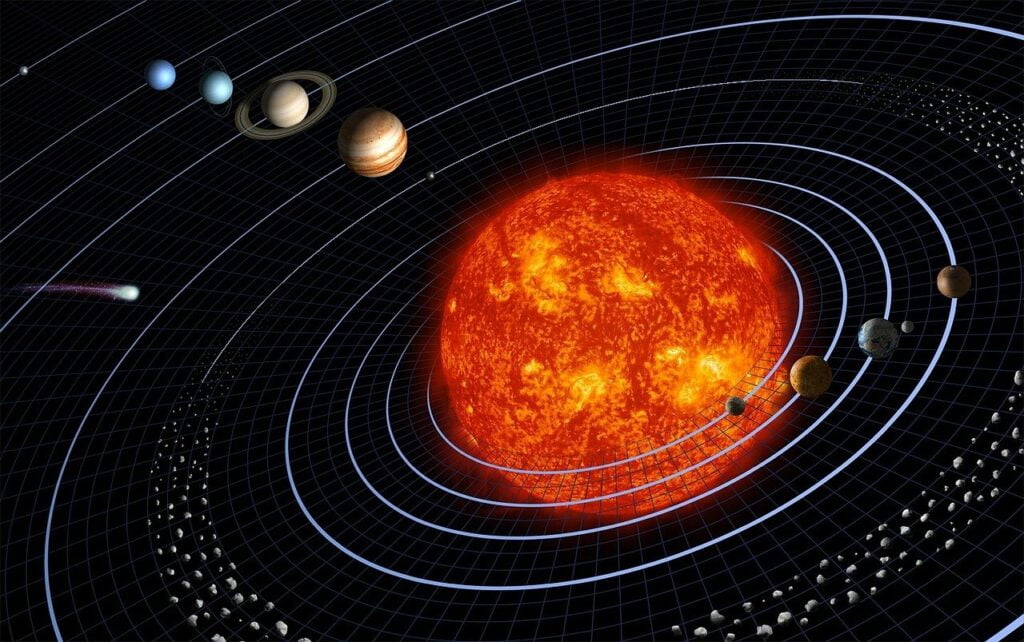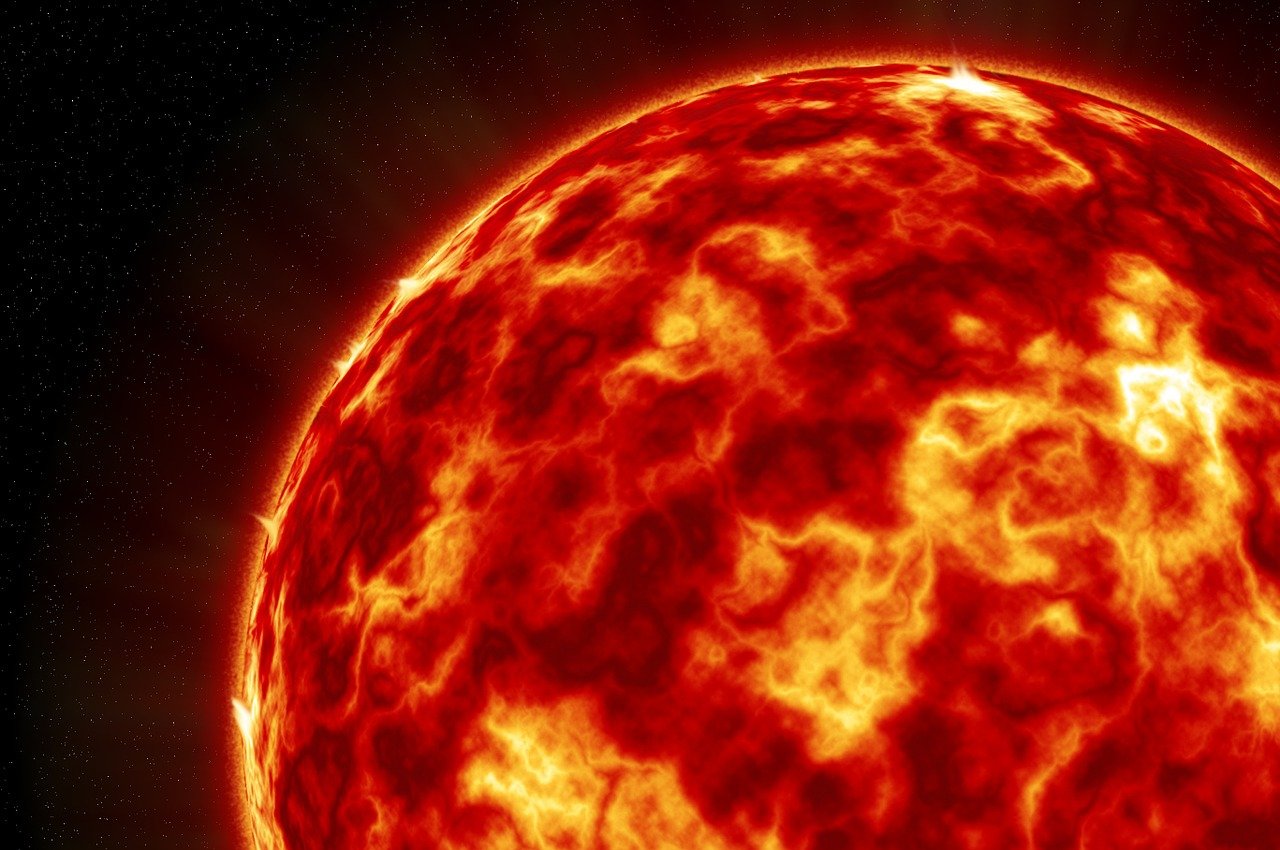
Delve into the fascinating world of our Sun, the celestial body that governs our existence and shapes our planet’s climate. Journey through its layers, uncover the mysteries of its magnetic field, and witness the awe-inspiring spectacle of solar activity. Explore the Sun’s evolution through the ages and unravel its impact on other planets in our solar system. Discover its role as a vital source of energy and its potential to power our future. And delve into the Sun’s profound influence on human culture and mythology, where it has been revered as a symbol of life, power, and cosmic order.
The Sun’s Structure and Composition
Our Sun is a remarkable celestial body, providing warmth, light, and energy to sustain life on Earth. Understanding its structure and composition is crucial to comprehending its behavior and its profound influence on our planet.
A Layered Structure
- Core: The Sun’s core is the densest and hottest region, occupying about 25% of the Sun’s radius. It is here, at temperatures exceeding 27 million degrees Celsius (50 million degrees Fahrenheit), that nuclear fusion takes place. This process converts hydrogen nuclei into helium nuclei, releasing a tremendous amount of energy. This energy, in the form of radiant heat and light, powers the Sun’s luminosity and drives its evolution.
- Radiative Zone: Surrounding the core is the radiative zone, extending from the core’s edge to about 70% of the Sun’s radius. In this region, energy transported from the core in the form of photons travels through the highly ionized gas, primarily by scattering and absorption interactions. The photons take millions of years to diffuse through the zone, gradually losing energy and contributing to the Sun’s overall luminosity.
- Convection Zone: The convection zone, occupying the outermost 30% of the Sun’s radius, marks the transition to a more turbulent region. Here, energy is transported not by radiation but by convection, where hot, less dense plasma rises to the Sun’s surface, while cooler, denser plasma sinks back towards the core. This convective circulation pattern drives the motion of the Sun’s outer layers and contributes to its dynamic appearance.
- Photosphere: The outermost layer of the Sun, the photosphere, is the visible surface we observe from Earth. It is a thin layer, about 200 kilometers (125 miles) thick, where the Sun’s energy is finally released as visible light and ultraviolet radiation. The photosphere is also characterized by granulation, the formation of small, hot cells that rise and cool, producing the distinctive granular pattern visible in telescope images.
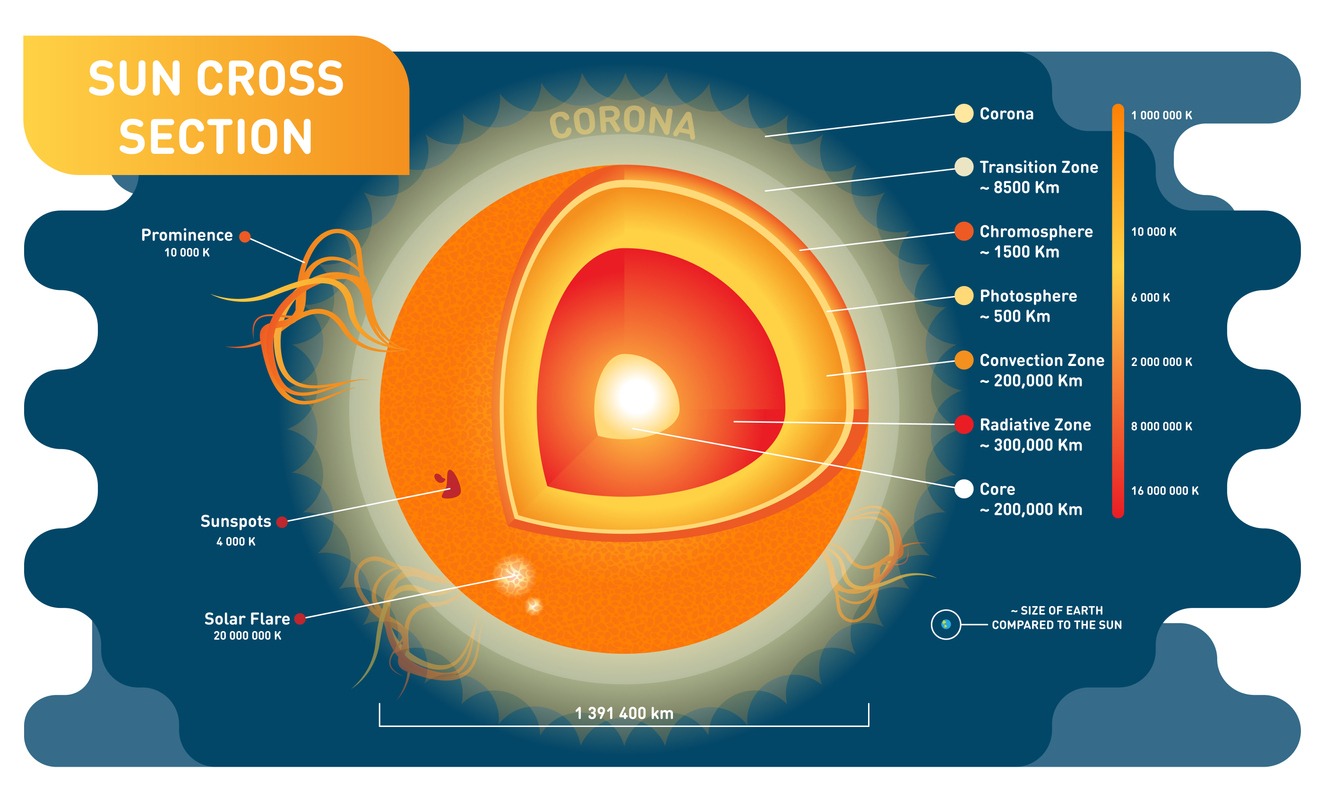
Composition: A Hydrogen-Helium World
The Sun’s composition is dominated by two elements: hydrogen (73%) and helium (25%). These elements are the remnants of the primordial hydrogen cloud from which the Sun formed billions of years ago. Trace amounts of other elements, like carbon, oxygen, and nitrogen, make up the remaining 2%.
Hydrogen, the most abundant element in the universe, is the fuel that powers the Sun’s nuclear fusion processes. The conversion of hydrogen nuclei into helium nuclei releases vast amounts of energy that sustain the Sun’s luminosity and drive its evolution. Helium, the second most abundant element in the Sun, is a byproduct of nuclear fusion and plays a crucial role in shaping the Sun’s structure and behavior.
The Sun’s Energy Output and Its Impact on Earth
The Sun’s core is the source of immense energy, converting about 620 million metric tons of hydrogen into helium every second. This energy is transported through the radiative and convective zones and finally released as light and heat at the photosphere.
The Sun’s energy output, measured as its luminosity, is nearly 400 trillion watts. This energy drives the Earth’s climate and sustains life on our planet. The Sun’s radiation provides warmth, drives photosynthesis, and powers the Earth’s winds and ocean currents.
Human activities have also begun to influence the Earth’s climate by altering the composition of the atmosphere, primarily through the emission of greenhouse gases. These gases trap heat from the Sun, leading to global warming and potential climate disruptions.
Understanding the Sun’s structure, composition, and energy output is essential for comprehending its behavior and its profound impact on our planet. The Sun is a remarkable cosmic entity, a testament to the power of nuclear fusion and the intricate workings of the universe.

The Sun’s Magnetic Field: A Dynamic Force Driving Solar Activity and Space Weather
The Sun, our nearest star, is a fiery ball of hot plasma, a state of matter where electrons are stripped away from their atoms, creating a sea of charged particles. Within this churning plasma, a powerful magnetic field is generated, influencing the Sun’s behavior and profoundly affecting our planet and its environment.
Origin and Generation of the Sun’s Magnetic Field
The Sun’s magnetic field arises from a process called convective dynamo action. Convection occurs within the Sun’s interior as hot, rising plasma moves towards the surface, while cooler plasma sinks. This churning motion of charged particles generates electric currents, which in turn create magnetic fields.
At the Sun’s core, where temperatures reach millions of degrees Celsius, the plasma is highly conductive, allowing these magnetic fields to extend throughout the Sun’s interior. The magnetic field lines become twisted and tangled as they are carried to the surface by convection, forming a complex and dynamic structure.
Structure and Evolution of the Sun’s Magnetic Field
The Sun’s magnetic field is not a static entity; it is constantly evolving, influenced by the Sun’s rotation and the turbulent nature of its plasma. At the surface of the Sun, visible concentrations of magnetic field lines appear as dark spots called sunspots. These sunspots form at the boundaries of regions where the magnetic field lines are particularly tangled and strong.
As the Sun rotates, these magnetic regions interact with each other, leading to the formation of more complex structures, such as filaments and prominences. Filaments are large loops of magnetic field lines extending high into the Sun’s atmosphere, while prominences are similar structures that erupt and briefly detach from the Sun’s surface.
Role of the Sun’s Magnetic Field in Solar Activity
The Sun’s magnetic field is the driving force behind various solar phenomena, collectively known as solar activity. These events range from the gentle flickering of sunlight to powerful explosions that can release immense amounts of energy.
Sunspots are particularly associated with solar flares, sudden bursts of intense radiation and particles. Flares occur when magnetic field lines snap apart, releasing stored magnetic energy as high-energy photons and particles.
Prominences, those fiery loops of magnetic field, can also erupt violently, releasing large amounts of plasma into the Sun’s atmosphere. These events are called coronal mass ejections (CMEs), and they can travel at millions of kilometers per hour, impacting Earth’s magnetosphere and causing space weather events.
Space Weather and Its Effects on Earth
Space weather is the term used to describe the conditions in the space surrounding Earth that are influenced by the Sun’s activity. These conditions can affect our planet and its technological infrastructure in various ways.
CMEs, in particular, can cause geomagnetic storms, disrupting satellite communications, navigation systems, and power grids. They can also increase the risk of auroras, or the colorful displays of light seen in high-latitude regions.
Understanding the Sun’s magnetic field and its influence on solar activity is crucial for predicting and mitigating the effects of space weather events. This knowledge allows us to protect our technological systems and ensure the safety of astronauts and satellites in space.
Solar Activity and Its Effects
Our nearest star, the Sun, is a dynamic and ever-changing celestial object. Its surface, known as the photosphere, is a roiling sea of hot plasma, constantly churning and bubbling with energy. This energy is released in various forms, ranging from gentle solar wind to explosive solar flares. These energetic events, collectively known as solar activity, have a profound impact on our planet, from causing spectacular auroras to disrupting our technology.
Types of Solar Activity
- Sunspots: These dark blemishes on the Sun’s surface are regions of intense magnetic activity. They are cooler than the surrounding plasma and appear dark because they emit less visible light. Sunspots are associated with the Sun’s magnetic field and play a crucial role in solar activity cycles.

- Solar Flares: These sudden bursts of energy, often accompanied by visible light and radio waves, are the most energetic events on the Sun. They are caused by the sudden release of magnetic energy stored in the Sun’s atmosphere. Solar flares range in size from small, localized events to massive, global eruptions.

- Prominences: These long, rope-like structures of hot plasma are suspended high above the Sun’s surface in the corona. They are formed by the rising and cooling of dense plasma. Prominences can be seen in visible light, and some can even extend far into space.

- Coronal Mass Ejections (CMEs): These giant clouds of plasma and magnetic field erupt from the Sun’s corona with speeds ranging from a few hundred kilometers per second to over a million kilometers per hour. CMEs are the most extreme form of solar activity and can have a significant impact on Earth’s atmosphere.

Mechanisms and Causes of Solar Activity
The Sun’s magnetic field is the driving force behind solar activity. The Sun’s magnetic field is generated by a process known as dynamo action, which is driven by the Sun’s rotation. The magnetic field is constantly changing and evolving, and it can become tangled and twisted. When this happens, it can lead to the release of energy in the form of solar flares and CMEs.
Magnetic reconnection is another important process in solar activity. Magnetic reconnection occurs when two magnetic fields lines reconnect, releasing stored magnetic energy. This energy can then be converted into other forms of energy, such as heat and radiation.
Effects of Solar Activity on Earth’s Atmosphere
Solar activity has a wide range of effects on Earth’s atmosphere. Some of the most notable effects include:
- Auroras: Auroras, also known as the Northern Lights and Southern Lights, are caused by the interaction of charged particles from the Sun with Earth’s atmosphere. They appear as colorful displays in the sky, often in the polar regions.

- Disruptions of radio communication: Solar activity can disrupt radio communication, especially at high frequencies. This is because the charged particles from the Sun can interfere with the propagation of radio waves.
- Damage to satellites: Solar activity can also damage satellites, which are often exposed to the harsh radiation environment of space. This damage can range from minor malfunctions to complete destruction.
Risks and Hazards Posed by Extreme Solar Storms
Extreme solar storms, such as coronal mass ejections with particularly high speeds and energetic particles, pose a significant risk to our modern technological infrastructure. These storms can cause widespread power outages, disrupt telecommunications networks, and damage critical infrastructure such as power grids and air traffic control systems.
In addition to these direct effects, extreme solar storms can also have indirect effects on our society. For example, widespread power outages can lead to economic disruption, and disruptions to telecommunications networks can hinder emergency response efforts.
The Sun’s Evolution and Future
Our Sun, a seemingly stable celestial body that has illuminated our planet for billions of years, is embarked on an extraordinary odyssey, an intricate dance of energy conversion and stellar metamorphosis. From its humble beginnings as a swirling cloud of gas and dust, the Sun has undergone a remarkable transformation, and its future holds even more captivating transformations.
Formation and Main Sequence: A Star is Born
Approximately 4.57 billion years ago, our Sun formed within a vast, swirling molecular cloud in the Orion Arm of the Milky Way galaxy. This cloud, a chaotic mix of hydrogen, helium, and trace elements, was stirred by gravitational forces, collapsing under its own immense weight. As the cloud contracted, its density and temperature increased, triggering a series of nuclear reactions in its core.
At the heart of the collapsing cloud, a protostar, the precursor to our Sun, emerged. The intense heat and pressure within the protostar’s core initiated fusion reactions, converting hydrogen atoms into helium atoms. This process released immense amounts of energy, propelling the protostar outwards, forming the Sun we see today.
For the next 10 billion years, the Sun will remain in its main sequence phase, a stable period characterized by the steady fusion of hydrogen into helium in its core. This continuous energy release powers the Sun’s vibrant luminosity, allowing it to maintain its enormous gravitational pull, holding our solar system together.
Red Giant Phase: A Transformational Transition
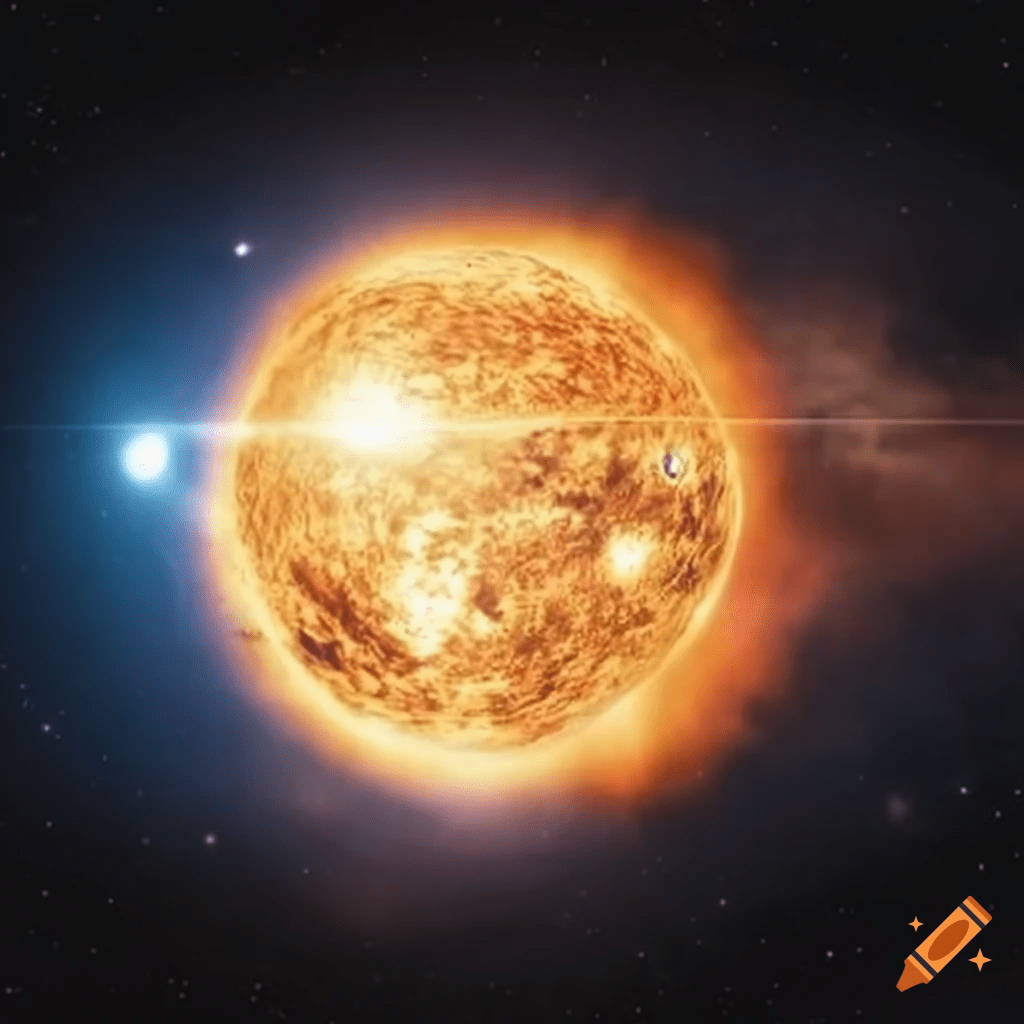
As the Sun exhausts its hydrogen fuel in its core, it will embark on a remarkable transformation. Its core will shrink and become denser, while its outer layers will swell and expand, engulfing the inner planets, including Earth. This dramatic transformation marks the beginning of the Sun’s red giant phase.
The Sun’s red giant stage will last for approximately 1 billion years. During this period, its luminosity will increase significantly, causing the Earth’s oceans to evaporate, leaving behind a barren, scorched world. Life as we know it will cease to exist on our planet.
White Dwarf Phase: A Cool, Luminescent Ember
After its red giant phase, the Sun will shed its outer layers, forming a planetary nebula. The remaining core, composed primarily of helium and carbon, will collapse into a white dwarf, a tiny, dense star with a surface temperature of tens of thousands of degrees Celsius.
As a white dwarf, the Sun will no longer fuse nuclear fuel. Instead, it will cool gradually over trillions of years, gradually fading into a cold, inert celestial remnant.

Impact on Earth’s Habitability
The Sun’s evolution will have a profound impact on Earth’s habitability. During the red giant phase, Earth will be engulfed by the Sun’s expanding atmosphere, rendering our planet uninhabitable. The Sun’s increased luminosity during this phase will also likely lead to the evaporation of water from Mars, further reducing its chances of supporting life.
However, the Sun’s eventual transformation into a white dwarf will pose a lesser threat to Earth. While the Sun’s luminosity will continue to decline, it will no longer be hot enough to threaten our planet. Life, if it were to reemerge on Earth, would face a much cooler, but potentially habitable, environment.
Future of Life in the Solar System
The Sun’s evolution will set the stage for the future of life in our solar system. The possibility of life emerging on other planets, such as Jupiter’s moons Europa and Enceladus, where subsurface oceans may exist, will depend on the continued habitability of these environments as the Sun ages.
The Sun’s journey through time is a mesmerizing tale of stellar transformation, a testament to the enduring power of physics and the intricate dance of energy and matter. As our Sun continues its cosmic odyssey, we can only marvel at its grandeur and contemplate the potential for life to adapt and evolve amidst the Sun’s changing environment.
The Sun’s Enduring Influence: A Realm of Planetary Interactions
Our Sun, a majestic celestial body at the heart of our solar system, exerts a profound influence on all the planets that orbit it. Its radiant energy, magnetic field, and solar wind permeate the cosmic neighborhood, shaping the atmospheres, magnetospheres, and climates of these celestial companions.
Radiant Energy: The Lifeblood of Planetary Systems
At the core of the Sun’s influence lies its immense outpouring of radiant energy. This constant bombardment of electromagnetic radiation provides the energy that drives atmospheric processes, governs planetary climates, and enables life to flourish.
On Earth, the Sun’s energy fuels photosynthesis, the process by which plants convert sunlight into chemical energy, the very foundation of terrestrial ecosystems. Solar radiation also heats the planet’s atmosphere, driving winds, ocean currents, and weather patterns.
Magnetic Fields: Shielding and Shaping Planetary Dynamics
The Sun’s magnetic field, a vast and intricate tapestry of charged particles, extends outward, interacting with the magnetic fields of the planets. This interplay plays a crucial role in shaping planetary magnetospheres, protective bubbles that deflect harmful solar particles and radiation.
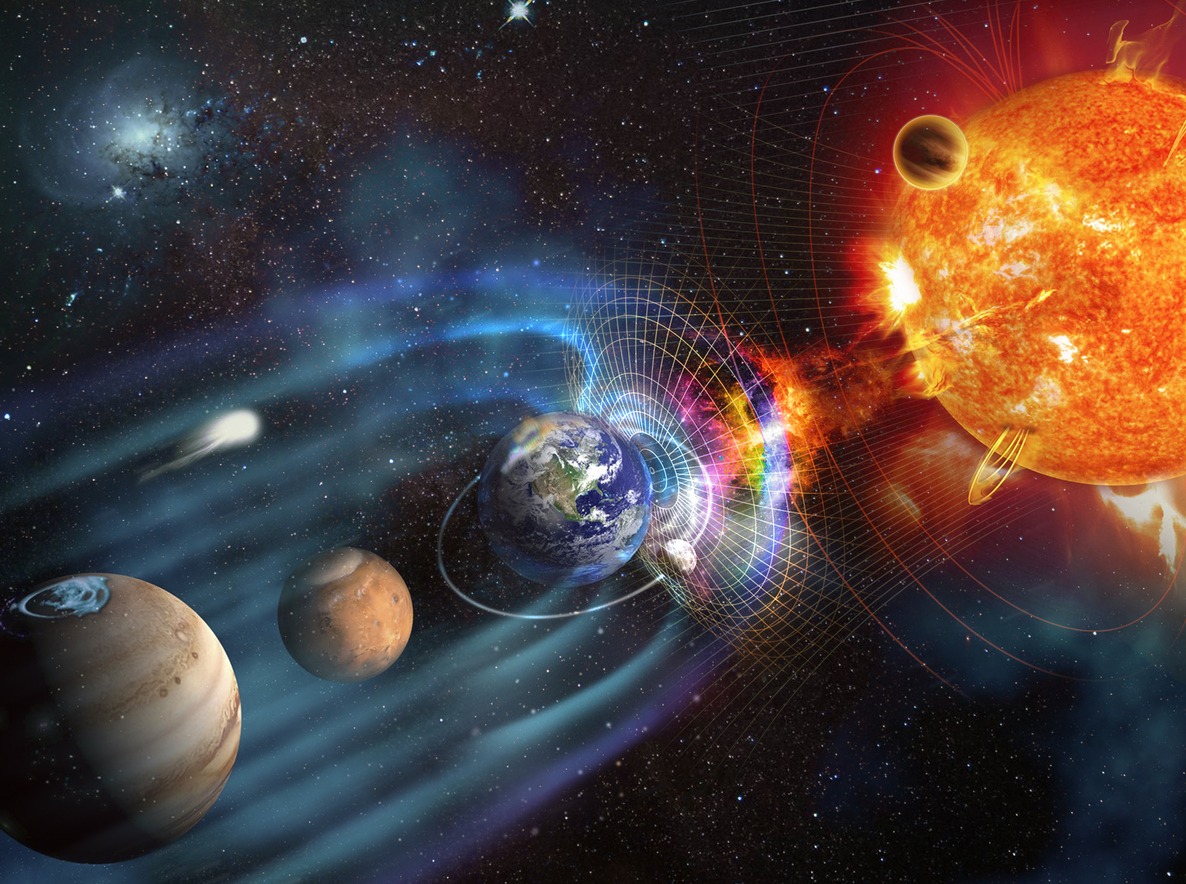
The magnetosphere of Earth, for instance, shields us from the intense radiation of the Sun’s corona, preventing the disruption of life-sustaining processes. However, during periods of intense solar activity, known as solar storms, the magnetosphere can be weakened, allowing a temporary influx of radiation.
Solar Wind: A Cosmic Breeze with Energetic Consequences
The Sun’s magnetic field also drives the solar wind, a continuous stream of charged particles that streams outward at supersonic speeds. This energetic plasma interacts with planetary magnetospheres, creating dynamic interactions that shape auroras, the spectacular displays of light seen in Earth’s high-latitude regions.
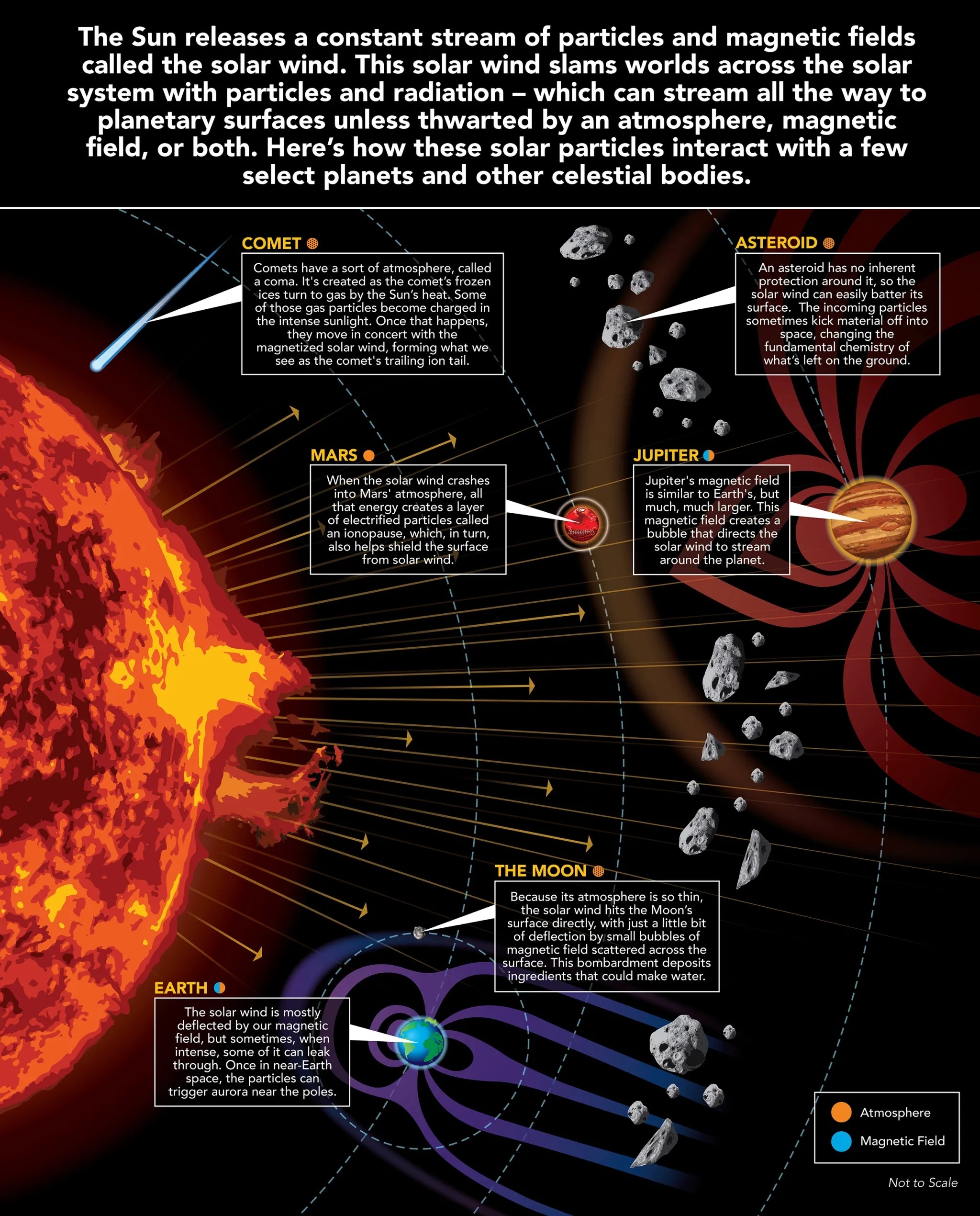
The solar wind’s influence extends beyond the solar system, affecting interplanetary dust and even potentially influencing the evolution of other planetary systems. By examining the properties of the solar wind, astronomers can gain insights into the conditions that may exist in other star systems.
The Sun’s Role in Planetary Evolution: A Cosmic Teacher
The Sun’s influence on the planets is not merely a consequence of its proximity; it is a fundamental driving force in shaping planetary evolution. The interplay between the Sun’s radiation, magnetic field, and solar wind plays a critical role in determining the habitability of planets, the potential for life to emerge and thrive.
Understanding the Sun’s impact on other planets allows us to better appreciate the unique conditions that have allowed life to flourish on Earth. By studying the interactions between the Sun and its planetary companions, we gain valuable insights into the processes that govern planetary evolution and the potential for life in the cosmos.
Conclusion: A Radiant Realm of Cosmic Interactions
The Sun, our celestial anchor, stands as a beacon of energy and influence, shaping the destinies of the planets that orbit it. Its radiation, magnetic field, and solar wind weave a cosmic tapestry of interactions, driving planetary processes, shaping atmospheric dynamics, and influencing the potential for life beyond our own world. As we continue to explore the vast expanse of the universe, we seek to unravel the mysteries of planetary evolution, guided by the lessons learned from our Sun and its celestial entourage.
The Study of the Sun: Recent Discoveries and Future Directions
Our sun, a magnificent ball of burning plasma, is the lifeblood of our planet and the foundation of our solar system. It has been the subject of intense scientific study for centuries, yet it continues to unveil new mysteries and surprises. In recent years, remarkable advances in solar physics have shed light on the Sun’s inner workings, its interactions with the surrounding space environment, and its far-reaching influence on the cosmos.
Key Recent Discoveries in Solar Science
- Gravitational Waves from Solar Flares: In a groundbreaking breakthrough, scientists detected gravitational waves from a solar flare, the first time such waves have been observed from a stellar source. This discovery opens up a new window into the dynamics of solar flares, providing insights into the immense energy released during these explosive events.
- Dark Matter Interactions with the Sun: Dark matter, the mysterious substance comprising about 85% of the universe’s matter, may be interacting with the Sun in ways that could affect its evolution and influence the Earth’s climate. Studies are underway to detect and quantify the potential effects of dark matter on the Sun’s magnetic field, rotation, and atmospheric composition.
Ongoing Advancements in Solar Observation Techniques
- Ground-Based Telescopes: Ground-based telescopes, with their large apertures and advanced instrumentation, continue to provide high-resolution images and detailed observations of the Sun’s surface and atmosphere. Recent innovations include the use of adaptive optics to compensate for atmospheric turbulence and the development of specialized instruments to study the Sun’s magnetic fields and energetic particles.
- Space-Based Observatories: Space-based observatories, immune to the distorting effects of Earth’s atmosphere, allow for continuous monitoring of the Sun from above. These missions, such as SOHO, the Solar Dynamics Observatory, and the Parker Solar Probe, provide a comprehensive view of the Sun’s activity, from its core to its outer reaches.
- Robotic Probes: Robotic probes, such as the Parker Solar Probe and the Juno spacecraft, are venturing closer to the Sun than ever before, providing unprecedented insights into its extreme environment. These probes are equipped with advanced instruments to measure the Sun’s heat, magnetic fields, and particle fluxes, allowing for a deeper understanding of its inner workings.
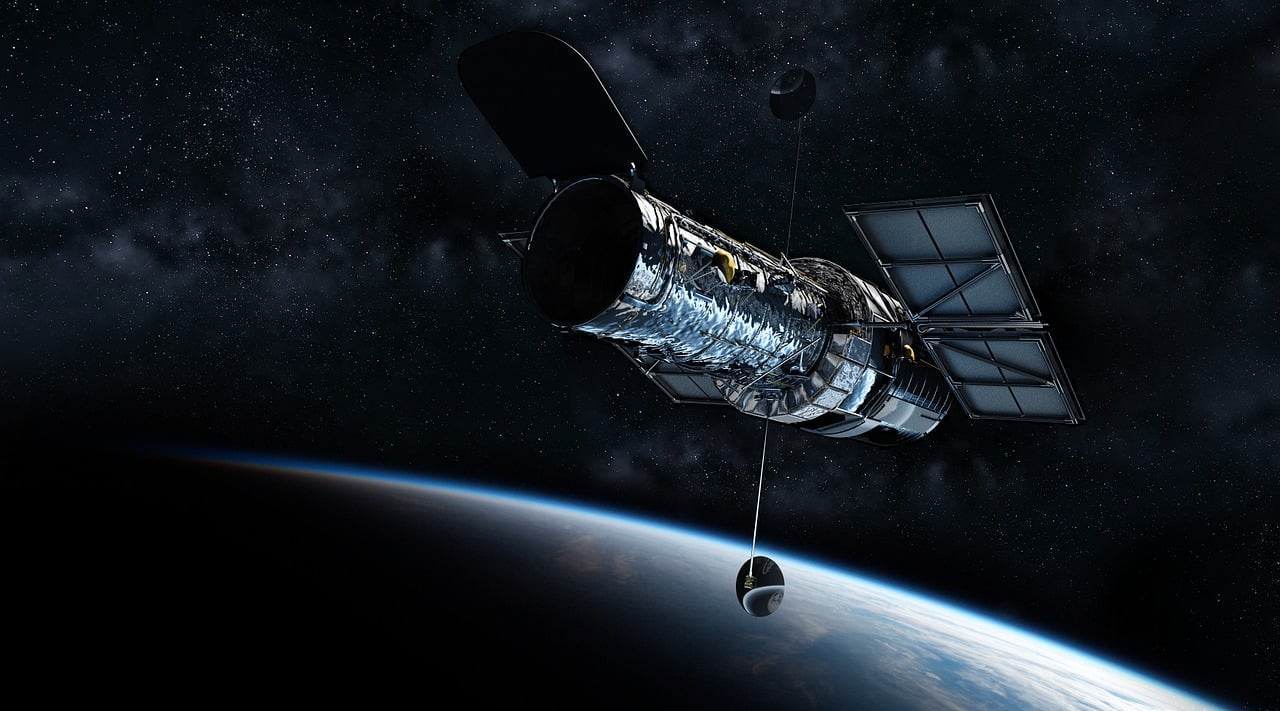
Future Directions of Solar Research
- Decoding the Sun’s Internal Structure: Unveiling the Sun’s internal structure, including its composition, temperature, and density profiles, remains a major challenge in solar physics. Studies are underway to develop new observational techniques and theoretical models to probe the Sun’s interior and better understand the processes that drive its energy production and magnetic activity.
- Predicting Solar Activity with Greater Accuracy: Accurately predicting solar activity, such as the occurrence of solar flares and coronal mass ejections, is crucial for protecting satellites, infrastructure, and astronauts from space weather hazards. Advanced forecasting models and data assimilation techniques are being developed to improve our ability to anticipate solar events and mitigate their potential impacts.
- Exploring the Sun’s Role in the Broader Context of the Universe: The Sun, though seemingly isolated in our solar system, is an active participant in the broader cosmic environment. It interacts with interstellar gas and dust, influences the evolution of nearby stars, and contributes to the formation of the heliosphere, a vast bubble of plasma that surrounds our solar system. Future research will focus on understanding the Sun’s connections to the wider cosmos and its role in shaping the structure and evolution of our galaxy.
The study of the Sun is a dynamic and ever-evolving field. As our technological capabilities and theoretical understanding advance, we can expect to continue unraveling the Sun’s mysteries and gaining a deeper appreciation of its profound influence on our planet and the universe as a whole.
The Sun as a Source of Energy and Its Potential for the Future
The Sun: A Life-Sustaining Force
The Sun’s energy powers the photosynthetic process in plants, enabling them to convert sunlight into chemical energy stored in the form of glucose. This process underpins the entire food chain, providing sustenance for all living organisms. The Sun’s warmth regulates Earth’s climate, creating conditions favorable for life to thrive. Its radiation drives atmospheric circulation patterns, generating winds and ocean currents that distribute heat around the globe.
Solar Energy Conversion: Unleashing the Sun’s Power
Solar energy conversion technologies harness the Sun’s radiant energy and transform it into usable forms of power, such as electricity and heat. Photovoltaic (PV) cells are the most common solar energy conversion technology, converting sunlight directly into electricity. These cells utilize a semiconductor material that absorbs sunlight, causing electrons to flow, generating an electric current.
Concentrating solar power (CSP) systems focus sunlight onto a receiver, generating heat that can be used to drive turbines and produce electricity. Solar thermal systems collect and store solar energy in the form of hot water or steam, which can be used for space heating, water heating, or industrial applications.

Solar Energy: A Sustainable and Environmentally Friendly Alternative
Solar energy stands out as a sustainable and environmentally friendly alternative to fossil fuels. Unlike fossil fuels, which are finite and release harmful greenhouse gases into the atmosphere, solar energy is an inexhaustible source of energy that does not produce any pollution. Its use reduces our reliance on fossil fuels, mitigating climate change and preserving natural resources.
Challenges and Opportunities in Expanding Solar Energy Utilization
Despite its numerous advantages, solar energy faces several challenges in its widespread adoption. The intermittency of sunlight is a significant limitation, as solar energy production cannot match the constant demand for electricity. Storage technologies are crucial to address this challenge by storing excess energy generated during sunny periods for use during off-peak times.
The high upfront cost of solar energy installations is another barrier. However, as technology advances and manufacturing costs decrease, the cost of solar energy is becoming increasingly competitive with conventional energy sources. Government incentives and policies can further accelerate solar energy adoption by reducing costs and promoting investment in solar energy infrastructure.
The Sun in Human Culture and Mythology
From the dawn of human consciousness, the Sun, our celestial orb of life-giving energy, has captivated our imaginations, inspiring awe and reverence. Its daily ascent and descent across the sky have marked the rhythm of our lives, influencing our agriculture, rituals, and cultural beliefs. The Sun’s radiant presence has woven itself into the fabric of human civilizations, shaping our understanding of the cosmos and leaving an indelible mark on our art, mythology, and symbolism.
The Sun as a Divine Presence: Solar Deities and Religious Beliefs
The Sun’s immense power and influence have led to its widespread veneration as a divine entity across various cultures. From the ancient Egyptians’ Ra, the creator god who sailed across the sky in his solar boat, to the Mayan deity Kinich Ahau, the embodiment of heat, light, and creation, solar deities have occupied a central position in many pantheons. These divine figures represented the Sun’s life-giving energy, its role in maintaining the cosmic order, and its connection to the cycle of life, death, and rebirth.
Solar Worship and Rituals: Honoring the Divine Source
The reverence for the Sun manifested in various forms of worship and rituals across ancient civilizations. The Egyptians constructed monumental temples dedicated to Ra, while the Incas built shrines atop towering mountains to honor Inti, their solar deity. These rituals often involved astronomical observations, offerings, and processions, aimed to appease the Sun god and ensure its continued benevolence.
Solar Symbolism: A Lingua Franca of Cosmic Power
The Sun’s symbolic representation has transcended linguistic and cultural barriers, becoming a universal emblem of power, energy, and divinity. The circular shape of the Sun has been widely adopted as a symbol of totality, perfection, and the unending cycle of life. Its radiant glow signifies enlightenment, wisdom, and the divine spark within humanity. The Sun’s presence in art, from ancient paintings and sculptures to modern works, reflects its enduring significance as a source of awe and inspiration.
Solar Eclipses: Enigmatic Celestial Events and Catalysts of Scientific Inquiry
The mysterious and awe-inspiring phenomenon of solar eclipses has held a profound fascination for humans throughout history. These temporary darkenings of the Sun have been interpreted as omens of doom, divine interventions, or opportunities for spiritual renewal. However, they have also served as catalysts for scientific inquiry, prompting ancient astronomers to study the celestial mechanics that underlie these events.

The Sun’s Enduring Impact: A Beacon of Scientific Understanding
Our modern understanding of the Sun has been shaped by centuries of scientific observation and exploration. From Galileo’s groundbreaking telescopic observations to the recent Parker Solar Probe mission, scientists have delved into the Sun’s fiery depths, unlocking the secrets of its composition, magnetic fields, and the processes that drive its energetic outbursts.
You may also like:
Mercury: The Closest Planet to the Sun
Venus: The Earth’s Twin or a Very Different Planet?
Mars: Comprehensive Exploration, unveiling the Mysteries
Jupiter: A Cosmic Giant – Symphony of Storms
Saturn: A Gaseous Giant with Enthralling Rings and Diverse Moons
Bibliography
- Aveni, Anthony F. (1995). Empires of Time: Calendars, Clocks, and Cultures. The University of Chicago Press.
- Eliade, Mircea (1959). Cosmos and History: The Myth of the Eternal Return. Harper & Brothers.
- Frazer, James George (1922). The Golden Bough: A Study in Magic and Religion. Macmillan.
- Lewis-Williams, David (2002). The Mind in the Cave: Consciousness and the Origins of Art. Thames and Hudson.
- Pugh, Susannah (2004). The Sun and the Sacred: Symbolism and Myth. I.B. Tauris.
- Aschwanden, M. J. (2005). Physics of the solar corona (2nd ed.). Springer.
- Priest, E. R. (2002). Solar magnetohydrodynamics (2nd ed.). Dordrecht: Kluwer Academic Publishers.
- Webb, D. F. (2004). The solar corona: A historical review. Cambridge University Press.
- Gosling, J. T., & Pizzo, V. J. (1999). The dynamic corona: From observations to theories. University of Arizona Press.
- Schwenn, R. Space Weather: An Introduction. Berlin, Heidelberg: Springer-Verlag. 2006.

